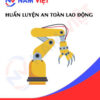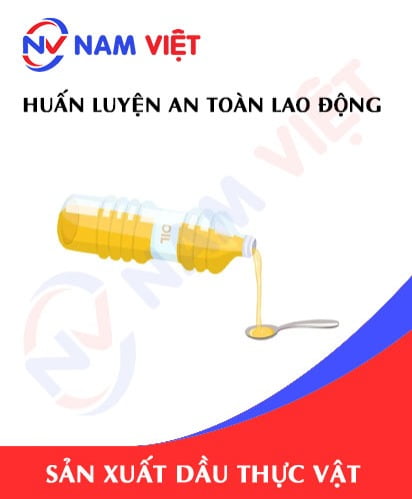Occupational Safety Training for ATM Manufacturing
99,000 ₫
Note: The above price is calculated for one person, and the price may fluctuate depending on the number of learners participating in the course and market movements. For more accurate pricing support, please refer to the price list or contact our consulting staff directly.
Occupational safety is an important issue in ATM manufacturing factories and needs to be addressed promptly to ensure the health and safety of workers and enhance the reputation of enterprises. The Occupational Safety Training course is one of the effective solutions to raise awareness on how to prevent workplace accidents for workers participating in ATM manufacturing.
Table of Contents
Toggle1. Overview of ATM machine
a. What is an ATM machine?
An ATM machine (Automated Teller Machine) is an automated device used to perform financial transactions. It allows users to withdraw cash from their bank accounts without having to go directly to the bank. ATM machines also provide other functions such as checking account balances, depositing money, transferring money, paying bills, and viewing recent transaction information.
Users usually use an ATM card (bank card or debit card) and a PIN (Personal Identification Number) to access the ATM machine and perform transactions. ATM machines are often placed in banks, supermarkets, shopping centers, airports, and other public places to facilitate user access to financial services.
ATM machines have become an indispensable part of the modern banking system, bringing convenience and flexibility to users in accessing cash and managing personal finances.

b. Types of machinery for ATM machine manufacturing
In the process of manufacturing and assembling ATM machines, many types of machinery and equipment are involved to ensure that the operation process is carried out accurately and effectively. Below are some types of machinery commonly used in the process of manufacturing and assembling ATM machines:
- CNC lathe (Computer Numerical Control): Used to machine metal parts to the required dimensions and shapes. CNC lathes can perform operations such as cutting, drilling, grinding, and turning precisely.
- Metal press: Used to press metal sheets into basic components of ATM machines, such as the main frame, outer shell, and other parts.
- Welding machine: Used to weld metal parts together to form a solid structure of the ATM machine.
- Sheet metal cutting and bending machine: Used to cut and bend metal sheets into components such as the outer shell, machine door, front, and back of the ATM machine.
- Label printing and cutting machine: Used to print and cut identification labels for parts and modules of the ATM machine.
- Function testing machine: Used to test the features and performance of parts and modules of the ATM machine before final assembly.
- Industrial robot: Can be used to perform automated tasks in the assembly process, such as moving and attaching parts, checking, and quality control.
These are just some examples of the types of machinery involved in the process of manufacturing and assembling ATM machines. The technology and equipment used may vary depending on each manufacturer and specific production process.

c. ATM machine manufacturing enterprises in Vietnam
In Vietnam, there are several enterprises manufacturing ATM machines. Below are some well-known enterprises in this field:
- Hanel Technology One Member Limited Liability Company: Hanel is one of the leading enterprises in Vietnam in manufacturing ATM machines. Hanel provides products and services in the field of information technology, including ATM machines, POS machines, and other electronic banking solutions.
- NCR Vietnam Company Limited: NCR is a global information technology corporation with a branch in Vietnam. NCR manufactures and provides products and solutions in the field of cash management, including ATM machines and other automated devices.
- FPT IS Joint Stock Company: FPT IS is a leading information technology company in Vietnam and has participated in manufacturing ATM machines. FPT IS provides solutions and services in the banking and financial sector, including developing and supplying ATM products.
- Nautilus Hyosung Company Limited: Nautilus Hyosung is an enterprise from Korea with a branch in Vietnam. This company specializes in manufacturing banking automation equipment, including ATM machines.
These are just some examples of enterprises manufacturing ATM machines in Vietnam. There may be many other enterprises operating in this field, and this list may change over time.

d. Specific jobs in ATM machine manufacturing factory
Group 1
- General director, deputy general director, department heads in ATM machine manufacturing factory.
Group 2
- Safety officer: managing safety in the factory, designing safety procedures, supervising, and urging employees to comply with safe working procedures.
Group 3
- Metalworking: The metalworking process includes cutting, bending, pressing, and welding metal components to form the basic parts of ATM machines such as the main frame, outer shell, and machine door.
- Assembly and installation: This job involves assembling parts and modules of ATM machines such as processors, screens, keyboards, printers, card readers, and other parts. Then, the modules are installed into the machine shell and other parts are accurately connected.
- Quality inspection: After assembly, ATM machines are quality inspected to ensure that functions and features operate accurately and reliably. This inspection may include electrical testing, network connection testing, component and module operation testing, and security testing.
- Software installation and configuration: Before ATM machines are delivered to customers, software is installed and configured according to requirements. This includes installing the operating system, banking transaction software, and other settings such as language, currency rate, and local information.
- Maintenance and repair: After ATM machines are assembled and configured, factories may provide maintenance and repair services to ensure that ATM machines operate securely.
Group 4
- Office, service, sales, marketing jobs.
- Production management, quality management, human resources management, materials management, financial accounting management.
- Design and research: This job includes the process of researching and designing ATM machines, including identifying requirements, technical drawing, programming, and testing features and user interfaces.
2. Overview of occupational safety training course for ATM machine manufacturing
Within the scope of this article, we focus on issues related to group 3, because group 3 is the group directly involved in the production process, bearing the highest risks of occupational safety. Refer to other groups here
a. What is group 3 occupational safety training?
- Group 3 occupational safety training consists of lessons providing awareness of how to prevent occupational accidents for employees.
- The occupational safety training course will help employees recognize and avoid hazards, thereby reducing the risks of occupational accidents while working.
REGISTER FOR OCCUPATIONAL SAFETY TRAINING SERVICE
b. Training duration
First-time occupational safety training duration
- Total training duration is at least 24 hours, including test time.
- 8 hours of theoretical study on the system of occupational safety and hygiene policies and laws
- 8 hours of theoretical study on basic knowledge of occupational safety and hygiene
- 4 hours of theoretical study on specialized training content
- 2 hours of practical training on specialized training content
- 2 hours of theoretical examination at the end of the training course
The occupational safety training center will divide the time into several training sessions depending on the arrangement for employees. Normally, there will be 6 training sessions over 3 days, provided that the manufacturing enterprise arranges continuous study time.
Periodic occupational safety training duration
- Before the occupational safety card expires, employees who want renewal must attend a periodic occupational safety training course, with a periodic training duration of at least 50% of the first-time training duration.
Explanation: The total periodic occupational safety training duration is at least 12 hours, including test time. After completing the periodic training course and passing the examination, employees will be reissued or extended the occupational safety card.
c. Content of the training course
| No. | TRAINING CONTENT | TRAINING DURATION (HOURS) | |||
| Total | Including | ||||
| Theory | Practice | Test | |||
| I | System of occupational safety and hygiene policies and laws | 8 | 8 | 0 | 0 |
| 1 | Overview of the system of legal documents on occupational safety and hygiene. | 6 | 6 | ||
| 2 | System of occupational safety and hygiene standards and technical regulations. | 1 | 1 | ||
| 3 | Specific regulations of state management agencies on occupational safety and hygiene when constructing new, expanding, or renovating works, facilities for production, use, storage, preservation, and inspection of machines, equipment, materials, and substances subject to strict occupational safety and hygiene requirements. | 1 | 1 | ||
| II | Basic knowledge of occupational safety and hygiene | 8 | 8 | 0 | 0 |
| 1 | Basic knowledge of hazardous and harmful factors in the workplace. | 4 | 4 | ||
| 2 | Methods of improving working conditions. | 1 | 1 | ||
| 3 | Safety culture in manufacturing and business. | 1 | 1 | ||
| 4 | Rights and obligations of employers and employees; policies and regimes on occupational safety and hygiene for employees; functions and duties of the occupational safety and hygiene network. | 1 | 1 | ||
| 5 | Occupational safety and hygiene regulations, safety signs, instructions, and use of safety equipment and personal protective equipment; skills in first aid for occupational accidents, and prevention of occupational diseases. | 1 | 1 | ||
| III | Specialized training content | 6 | 4 | 2 | 0 |
| General knowledge of machines, equipment, substances that generate hazardous factors; analysis, assessment, and management of occupational safety and hygiene risks; safe working procedures with machines, equipment, and substances subject to strict occupational safety and hygiene requirements. | 6 | 4 | 2 | ||
| IV | Examination of occupational safety training content at the end of the course | 2 | 2 | 0 | 0 |
| Total | 24 | 22 | 2 | ||
See more training content of 6 groups
d. Occupational safety card
After completing the occupational safety training course and passing the examination, employees will be issued an occupational safety card (commonly referred to as occupational safety certificate for group 3).
The group 3 safety card will clearly show information such as full name, date of birth, job title, and specific working environment. It also includes training duration, a red stamp, and a signature certifying completion of the training course.
According to the regulations on issuing safety cards specified in clause 2 of article 24 of decree 44/2016/ND-CP, it is divided into 2 cases:
- In case the employer and the employee have a labor contract, the employer must sign, stamp, and seal the safety card for group 3 employees after completing the training course from the occupational safety training unit and passing the examination.
- In case of freelance or seasonal workers without a labor contract, the training unit must sign, stamp, and seal the safety card for workers after they complete the training course from the occupational safety training unit and pass the examination.

3. Identifying hazards affecting workers in ATM manufacturing
During the process of ATM manufacturing, there are several potential hazards that may affect workers. Below are some common hazards that need to be identified and addressed:
- Physical injuries: Tasks such as cutting, bending, pressing, and welding metal can cause physical injuries if safety rules are not followed. Risks of cuts, burns, impacts, or fractures may occur while handling metal parts.
- Chemical hazards: Some materials and chemical compounds used in ATM manufacturing can pose health risks if not handled properly or without protective measures. For example, welding solutions, cleaning agents, and anti-rust substances may cause skin, respiratory, or eye irritation.
- Electrical risks: During the assembly and configuration of ATMs, there is a risk of exposure to high voltage and electric current. Failure to comply with electrical safety regulations may lead to electric shocks or explosions.
- Mechanical failures: During operation and functionality testing, machine failures such as breakdowns, equipment malfunctions, or malfunctioning automation may occur. Handling these failures may endanger workers if not approached with caution and safety measures.
- Heat sources: During welding and the use of high-temperature equipment, risks of burns and explosions may occur if safety rules are not followed.
- Health issues: An unsafe working environment may cause health problems such as noise, intense lighting, polluted air, or work-related stress.

4. Common types of occupational accidents in ATM manufacturing
During the process of ATM manufacturing, there are several types of occupational accidents that commonly occur to workers. Below are some common types:
- Injuries from tools and equipment: The risk of injuries from cutting, grinding, pressing, and welding tools is very high. These may result from collisions, hand cuts, burns, impacts from machine parts, or sharp metal parts.
- Injuries from mechanical failures: Equipment failures such as breakdowns, falling heavy objects, or being trapped in machine parts may cause serious injuries to workers.
- Electric shocks: When working with electronic components and electrical systems, there is a risk of exposure to high current leading to electric shocks.
- Impacts from heavy objects: During transportation, installation, or moving of ATMs, there is a risk of heavy objects falling, crushing, or colliding with workers.
- Health risks: An unsafe working environment may cause health problems, including noise, metal dust, toxic gases, strong lighting, and work-related stress.
- Injuries during operation and maintenance: During the operation and maintenance of ATMs, risks such as tripping, slipping, scratches, or stumbling over objects may cause injuries.
- Injuries from other physical factors: Other physical factors such as high temperature, pressure, vibration, or mechanical impacts from operating systems of ATMs may also cause injuries to workers.
5. Safety measures in ATM manufacturing
When participating in ATM manufacturing, there are several important safety measures to protect the safety and health of workers. Below are some basic safety measures:
- Training and instructions: Ensure that all employees involved in ATM manufacturing are trained and instructed on safety rules, work procedures, and proper use of tools and personal protective equipment.
- Use of personal protective equipment: Ensure that all workers are provided with and correctly use personal protective equipment such as helmets, safety glasses, gloves, steel-toe shoes, protective clothing, and masks depending on the specific job requirements.
- Compliance with electrical safety rules: Ensure that workers understand and comply with electrical safety rules when working with electricity, including handling electrical equipment, correct wiring, and avoiding risks of electric shocks.
- Chemical management: Ensure that the use and storage of chemicals during manufacturing are carried out in accordance with regulations. Provide instructions on the safe use, storage, and handling of materials, compounds, and chemical solutions.
- Equipment inspection and maintenance: Ensure that equipment, machines, and tools are inspected, maintained, and serviced regularly to ensure safe and effective operation. Implement safety inspection procedures before use and promptly address failures and incidents.
- Monitoring and hazard response: Conduct continuous monitoring to detect potential hazards and establish rapid response plans.
- Regularly organize occupational environment monitoring in factories, collect and analyze harmful factors for workers, and adjust to reduce risks to prevent occupational diseases for them.
6. Benefits of occupational safety training in ATM manufacturing
An Toan Nam Viet provides enterprises with outstanding benefits after completing occupational safety training courses according to Decree 44/2016/ND – CP on occupational safety and hygiene. Companies, factories, and enterprises benefit as follows:
- Workers can recognize potential risks of occupational accidents and take preventive measures to avoid accidents.
- Enterprises can establish preventive measures in manufacturing, operation, and maintenance processes.
- Reduce costs in case of occupational safety risks.
- Ensure uninterrupted production processes, which helps increase productivity and product quality.
- Comply with legal regulations on occupational safety, avoiding legal risks.
- Enhance reputation and professionalism in all aspects, thereby improving the brand value of enterprises.
The training courses of An Toan Nam Viet are solutions to prevent external factors affecting individuals so that they can avoid dangers that may lead to injuries or, more seriously, death.
REGISTER FOR OCCUPATIONAL SAFETY TRAINING SERVICE
7. Customer feedback after completing occupational safety training in ATM manufacturing
An Toan Nam Viet has many years of experience in accompanying many enterprises across Vietnam in general and particularly in southern provinces. This responsibility is extremely valuable to An Toan Nam Viet, which is why occupational safety training is always emphasized and increasingly professional. The driving force for An Toan Nam Viet’s growth comes from both positive feedback and suggestions from enterprises. Below are some responses from our valued partners.
Bac Nam E&C Construction Investment Joint Stock Company
“This is the first time using the service at An Toan Nam Viet, I was very surprised by the enthusiastic 24/7 support of the consulting team. The class organization was very quick and convenient for our company, thank you very much to An Toan Nam Viet!”
Hoa Dat Construction and Trading Joint Stock Company
“The service of An Toan Nam Viet has helped us a lot in simplifying occupational safety and completing safety documents for work processes. The consulting team was enthusiastic and timely in answering our questions. 5 stars for An Toan Nam Viet.”
See more customer interviews after using the service of An Toan Nam Viet
8. Training capacity of An Toan Nam Viet
An Toan Nam Viet is a reputable and high-quality occupational safety training center in Vietnam today. Occupational safety training sessions are continuously conducted at manufacturing workshops, factories, or construction sites nationwide (63 provinces and cities in Vietnam).
REGISTER FOR OCCUPATIONAL SAFETY TRAINING SERVICE
Occupational safety training license
- An Toan Nam Viet has been inspected and certified by the Department of Safety of the Ministry of Labor – Invalids and Social Affairs, granting the certificate of eligibility for occupational safety and hygiene training. This further strengthens the training capacity of An Toan Nam Viet.

Documents and lectures
- Before being applied in occupational safety training courses, occupational safety training documents are reviewed and approved to ensure accuracy and effectiveness when applied.
- The teaching methods of lecturers are standardized according to the teaching standards of An Toan Nam Viet, developed by experts in occupational safety and hygiene training, aiming to bring the highest learning efficiency for trainees.
Facilities
- Controlling classroom factors that affect training will increase teaching efficiency and learning effectiveness for trainees.
- Training support facilities are always arranged with spacious classrooms that meet standards for area, lighting, and training equipment.
9. Reputable and high-quality national occupational safety training center
At An Toan Nam Viet, we always place our dedication to occupational safety training as our top priority. For us, imparting knowledge that helps workers know how to protect themselves, so they have a safe foundation on their path of livelihood, is a contribution to building the nation.
To ensure effective training, we prepare carefully and meticulously in every detail, even the smallest ones. From preparing tools, teaching equipment, curriculum, documents, sound, and lighting.
Our occupational safety training instructors are experts with many years of experience in the field. They even have research works on identifying hazards in all industries and ways to prevent them.
The lectures of our instructors are drawn from real-life experience and delivered in the most vivid and understandable way to workers. These factors make workers feel comfortable during training sessions and better absorb the knowledge we provide. Of course, the knowledge conveyed is always closely aligned with Decree 44/2016/ND-CP.
From there, workers acquire many measures to prevent hazards and protect themselves, while also applying them appropriately in their actual work.
Our occupational safety training center is proud to be a reputable and professional provider of occupational safety training services with the following advantages:
- Competitive training costs while ensuring training quality.
- Flexible training schedules adapted to the manufacturing situation of enterprises.
- Quick and legally compliant procedures for issuing occupational safety training certificates.
- Training instructors with many years of experience in the profession.
- Classrooms are controlled for factors affecting the training process, increasing teaching efficiency and learners’ knowledge absorption.
- Lectures compiled to suit occupational safety work at enterprises.
- An Toan Nam Viet works with dedication and professionalism to support customers accurately and quickly.

10. Additional reference materials for occupational safety training in ATM manufacturing
- Occupational safety training materials for ATM manufacturing
- Occupational safety training document set
- Occupational safety training test
- Occupational safety training curriculum for ATM manufacturing
- Occupational safety multiple-choice test for ATM manufacturing
1 review for Occupational Safety Training for ATM Manufacturing
No comments yet















namchinh.haiphong341
Đơn vị an toàn lao động uy tín tại Việt Nam nhé!